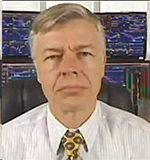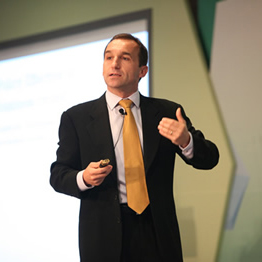What is quantitative easing?
Quantitative easing, or QE for short, is a vast expansion of the open market operations of a central bank. It is a rather unconventional monetary policy that is aimed at stimulating economic growth by allowing businesses to borrow money easier. The central bank essentially buys government securities and other securities from the market, which adds liquidity to capital markets. What this basically does is lowers the short-term interest rate and increases the money supply.
To get a bit more specific, you may have heard of the expression “printing money.” Well, central banks aren’t actually physically printing new bank notes. The central bank buys securities from banks with electronic money that did not previously exist. These security purchases increase the size of bank reserves in the economy by the quantity of assets purchased – this is where the name “quantitative” easing comes from.
As mentioned previously, the idea is to lower interest rates and spur economic growth by encouraging banks to loan out more money. The new money the banks obtain is used to buy new assets to replace the ones they sold to the central banks. This in turn increases stock prices and lowers interest rates allowing banks to loan out more money. An increase in loans increases demand by giving more money to businesses to expand. This should trickle down to the average person, stimulating spending activity. All of this, in theory, will stimulate economic growth.
It’s also worth mentioning that increasing the money supply keeps the value of a currency low. This makes investments, such as stocks, from a given country more attractive to foreign investors and also makes exports cheaper.
What is “unwinding” QE?
As you might imagine, buying all of those securities adds up quick and results in an accumulation of a lot of public debt. At some point the central bank will be pressured to “unwind” all of that by reducing its balance sheet, the value of the assets it holds.
From 2008 to 2014, the Fed’s QE program, which was designed to spur economic growth during the global financial crisis, doubled the balance sheet to USD 4.5 trillion. In 2014, the Fed stopped buying securities and ended the QE program. However, the Fed has reinvested principal payments and maturing securities since then, which has kept the balance sheet at right about the same level while keeping interest rates low until fairly recently. In December of last year, the Fed announced that it would not begin the process of reducing its balance sheet until normalization of the Federal Funds rate is well underway. And now appears to be that time as the Fed is aggressively tightening monetary policy, having just hiked interest rates for the third time in as many quarters at the 13-14 June meeting. But how will they commence with their plan to reduce the balance sheet?
The ECB is in a bit of a different situation as it is actually still in the midst of its QE program that only started in 2015. Previous to that it had implemented austerity measures across the Eurozone in attempt to combat the effects of the global financial crisis. Currently, the ECB is not forthcoming about their plans to get out of QE, but some would say that signs are pointing toward an end to the program coming soon. With the Eurozone economy doing better, a firming labor market, and rising inflation, the ECB president, Mario Draghi, has struck a less dovish tone in recent meetings. In the most recent meeting in June, the easing bias was completely taken out of the bank’s Communique signaling that their QE cycle may be drawing to a close. So rather than “unwinding” QE, the question for the ECB is how and when will the QE program come to an end?
So, with the Fed and the ECB appearing as if they are looking for an out, the question remains, how will they do it? It’s a pretty risky prospect, as it has been suggested by some that making the wrong decision could precipitate in disaster. With that in mind, we asked 18 economic experts the following questions:
1. How do you think the Fed will unwind its multi-trillion dollar balance sheet resulting from its stimulus program without severely upsetting the bond and equity markets?
2. How will the ECB, which is still stuck in a quantitative easing cycle, be able to bring it to an end without plunging Eurozone countries into yet another financial crisis?
 Livio Di Matteo
Livio Di Matteo
Quantitative easing has been an interesting chapter in macroeconomic history and has been a factor of some consequence in helping deal with the Great Recession. At the same time, seven years of ultra-loose monetary policy has run its course and continuing it further certainly risks laying the foundation for a round of future inflation. Moreover, it was an indirect way of stimulating aggregate demand and the lower interest rates generated have fueled housing prices and stock market prices as well as helped encourage the acquisition of a rather large mass of consumer and government debt. In particular, the low interest rates have rewarded debtors and punished savers. Despite the low interest rates, there has not been a massive rebound in private investment and many companies have been sitting on large cash reserves in part because of the economic uncertainty brought about by such a large-scale non-traditional monetary stimulus program. It is time to unwind quantitative easing on both the part of the Federal Reserve and the ECB but it will need to be done methodically and gradually so as not to upset bond and equity markets. The Fed and the ECB will need to announce a rules-based phasing out of quantitative easing – I would use the term “monetary re-balancing” – with a program of staged reductions in the rate of money creation. The key rule in winding things up should be gradualism.
Visit Livio’s blogs Worthwhile Canadia Initiative and Northern Economist 2.0
 Wolf Richter
Wolf Richter
I’m not into predicting what central banks will do and how they will do it – especially not for years down the road, and that’s what unwinding QE means. As soon as there is a big hiccup in the markets, they will flip-flop. Right now the markets are ignoring it, so the Fed and the ECB are moving forward (the ECB with baby steps). But that could change any time. With QE, ZIRP, and NIRP, they have engineered the greatest wealth transfer of all times, and they’re not about to unwind that wealth transfer. So in predicting what these central banks will do, you’re predicting what markets will do. I’m staying away from that.
Visit Wolf’s blog Wolf Street.
 David Merkel
David Merkel
The Fed always prefers passive approaches to policy. It gives them plausible deniability when things go wrong, and allows them to claim credit when things go right. They never want to be in the position where they do something and it is directly traceable to an action of theirs. In this situation, they will allow securities to mature. That’s all, and it is similar to what they did in 1952 when the Fed gained its practical independence from the US Treasury – they bought 30-year Treasury bonds, which is too long for monetary policy. The bonds were a special issue as the Treasury did not offer 30s to the public until the Seventies. They held them for 30 years, and let them mature.
So long as nothing is going wrong, the ECB will never end QE. The politics and institutional dynamics are even worse at the ECB than at the Fed. In a real inflationary crisis, Europeans would abandon the Euro as the German abandoned the Mark in the early ‘20s. After all, it is backed by neither a commodity nor a taxation authority. So long as deflation or moderate inflation is the norm, the ECB will do nothing – it will continue QE, reinvest the proceeds of maturing securities or at most, allow securities to mature.
The US Dollar is the cleanest “dirty shirt” among major currencies. It is a reasonable place to preserve relative value as far as currencies go.
Visit David’s website The Aleph Blog and follow him on Twitter here.

Daniel Lacalle
The Federal Reserve is already seriously behind the curve. Reducing the balance sheet by $600bn after a $4.7 trillion stimulus and delaying rate hikes simply make the problem more difficult to solve as we approach a change of cycle and the central bank finds itself with fewer tools. The Federal Reserve should take advantage of the unprecedented demand for USD and the fact that macro drivers and corporate profits are improving to accelerate its unwinding of the stimulus. However, it seems comfortable ignoring the risks of perpetuating bubbles in financial assets. By being too focused on financial markets it becomes what I call in my book “Escape from the Central Bank Trap” a “pyromaniac firefighter” that creates a massive bubble and presents itself as the solution when it bursts.
The Federal Reserve could be raising rates and unwinding its balance sheet by $50-100bn every month now that demand for bonds and equities remains solid and the employment, inflation and growth data is improving, while earnings estimates are increasing. There would be more than ample secondary market demand for a solid sterilization program.
The ECB is caught between a rock and a hard place. It is on its way to reaching a balance sheet size of more tan 25% of GDP of the Eurozone and inflation expectations are falling, unemployment and slack are still high, proving that the problem of the Eurozone was never of liquidity and low rates. When the ECB QE started, excess liquidity was c€185bn and today it is close to €1.3 trillion. In the process, highly indebted and deficit-spending countries saved billions in interest payments,… but their imbalances remain and they have spent those savings and more, making it almost impossible for the ECB to taper and raise rates because high-deficit countries would be unable to assume it. But at the same time, the overcapacity of the economy is perpetuated and many countries are calling for further spending increases and widening deficits. The ECB, therefore, needs to give a stronger message to governments so that they accelerate reforms to reduce excess spending and improve growth, lower taxes. If the ECB starts a sterilization program and manages long-term rates adequately, it could successfully promote structural reforms, help spur growth and use that massive excess liquidity to keep bond yields low while governments improve their fiscal position. This would reduce the perverse incentives that some may have to increase imbalances just because QE is there. Furthermore, as the crisis is way behind us, the ECB’s purchases would be easily offset by real investor demand, as fundamentals improve. There is still time before Europe enters a dangerous “Japanization” process.
Daniel has recently written a book on this subject entitled Escape from the Central Bank Trap. Read our review here.
Visit Daniel’s website and follow him on Twitter here.
 Karl Denninger
Karl Denninger
There is no obvious way to do that. The problem with QE-style programs, which are really just bond-buying schemes in which the central bank intentionally overpays in the hope of moving the price later, is that the “overpayment” already happened and is real.
This leads to a problem in that there’s an embedded loss in there that someone has to eat. Who’s going to eat it? If you shove it back into the market then what you “prevented” from being realized by QE in the first place (which was the entire point of the exercise) comes right back at you.
The Fed is trapped, basically. What they *hoped* was that this was a very short-term event which would lead to pretty-easily unwound distortions. That didn’t happen and instead of throwing in the towel early when it was recognized that it wasn’t going to work that way they doubled down. Now they’ve got a problem, in that trying to take their share of the treasury market back to where it was previously someone has to buy that from them — and the question becomes “at what price”?
The ECB has the same issue.
Visit Karl’s blog The Market Ticker and follow him on Twitter here.
 Miles Kimball
Miles Kimball
I expect the Fed to reduce reinvestment in mortgage-backed securities more and possibly earlier than they reduce reinvestment in long-term US Treasury bonds. The reduction in reinvestment will probably happened gradually, not all at once. There will be a pause in rate increases after the first announcement of reduction in reinvestment, both to compensate and for assessment.
I think the ECB will move very slowly to cut back on its stimulus. The key for avoiding another financial crisis is to keep raising effective capital requirements. If Trump appointees want to weaken or slow down the tightening of capital requirements, the key thing to watch is if European officials distance themselves from the US, saying they want tighter requirements than the US wants, or if they simply go along with a lean towards less strict capital requirements by the US.
Visit Miles’ blog Confessions of a Supply-Side Liberal and follow him on Twitter here.
 Dean Baker
Dean Baker
I think far too much is made of this unwinding as some incredibly complex task. Most research shows that QE was a modest positive for growth, adding at a most a cumulative 1.0 pp or so to GDP in both the U.S. and euro zone. Given this impact, it doesn’t make sense that the unwinding can be a huge negative, unless it were done very precipitously, which there would be no reason to do.
As a practical matter, I am surprised that there is not more discussion of the budgetary implications of the unwinding. In the U.S. a scenario in which the Fed unwinds along the schedule projected by the Congressional Budget Office adds close to $600 billion to the ten year deficit compared to a scenario in which it continues to hold the same amount of assets. Given that inflation is not likely to be a serious concern any time soon, this seems like just about the easiest route anywhere to reduce the deficit $600 billion.
I personally am not terribly concerned about the deficit and debt, but since many people are, having the Fed continue to hold its assets seems a much better option than cutting Medicaid and food stamps.
Visit Dean’s CEPR blog Beat the Press and follow him on Twitter.
 Neven Valev
Neven Valev
The exit will happen as the central banks stop buying new assets and do not replace the ones they already have upon reaching maturity. Unless they make radical moves which is very unlikely, there is little risk to the financial markets. Inflation is low, capacity is underutilized, investment is sluggish, and there is minimal wage pressure. Also, I cannot see from where a sudden economic boom may come. So, we may be lucky and wind down the quantitative easing without too much disruption.
Visit Neven’s websites TheGlobalEconomy.com and GlobalPetrolPrices.com.
 Antonio Fatas
Antonio Fatas
I personally do not see that managing large balance sheets is a big deal. I can imagine central banks will live with larger than normal balance sheets for a long period of time and will not engage in fast reductions of their size through selling of securities. The Federal Reserve has made this (almost explicit) and have discussed the ways in which monetary policy will be conducted.
The ECB is in a similar situation but one step behind. Yes, there are fears that when QE stops a financial crisis would happen but this is the same that the Fed had to go through during the taper tantrum and then it was not a big deal. QE will only stop in the Euro area when growth is strong enough and at that point there will be no need for further expansion of the ECB balance sheet.
But there is an issue you are not asking about which in my mind is much more fundamental: what happens when we hit the next recession? It is very likely that interest rates will still be zero or very low. This would require re-engaging QE. But what will be the effect then? Will we see even more QE fatigue and expectations that this might not work anymore? No obvious historical experiments (except maybe Japan during the financial crisis as it entered the crisis with near-zero interest rates).
Visit Antonio’s blog Antonio Fatas on the Global Economy and follow him on Twitter here.
 Carola Binder
Carola Binder
In January, Ben Bernanke outlined a few principles that should guide the Fed’s approach to balance sheet reduction. First, balance sheet reduction should not occur until “normalization of the level of the federal funds rate is well under way,” as the December 2016 FOMC press release noted. This leaves some room for interpretation, but I believe means that they want the federal funds rate to be far enough above the zero lower bound that there would be room for a few rate cuts if things were to take a turn for the worse. Second, balance sheet reduction should be simple and predictable. The Fed could take a passive approach, not rolling over or replacing assets as they mature, allowing the balance sheet to run down to a desirable size. Another way to add predictability is to make that desirable size known in advance– the FOMC would need to come to consensus about the balance sheet size and composition that they ultimately would like. Of course, it will not be up to Bernanke to orchestrate the balance sheet reduction, but I do hope that the current and future FOMC members will buy into these principles.
Visit Carola’s blog Quantitative Ease and follow her on Twitter.
 Elliott Morss
Elliott Morss
It is important to understand what “quantitative easing” (QE) can and cannot do. By putting money in circulation via purchasing assets, QE can lower rates. The hope is that lower rates will cause households and firms to spend more. But there are limits on what can be achieved by lowering rates. Keynes talked of “liquidity traps.” Liquidity traps occur when injections of cash into an economy by a central bank fail to result in more spending. This will happen when firms and individuals have decided not to spend more, whatever borrowing rates. To get the US out of the 2008 collapse more rapidly, Obama wanted the government to spend more (fiscal policy). But recognizing Congress would not pass a stimulus spending package, Bernanke did all he could with QE.
The balance sheets of both the Fed and the ECB have grown via their use of QE. Should their balance sheets be “unwound?” That is an accountant’s question and is not of greatest economic concern. The primary goal of these institutions is to keep their economies at full employment with price level stability. They should pursue this goal without regard to what it does to their balance sheets.
Visit Elliott’s website Morss Global Finance and follow him on Twitter.
 Roger Farmer
Roger Farmer
The most likely approach will be to allow existing holdings of long-dated bonds to expire. If the equity markets continue to appreciate at the current pace, allowing the Fed’s position in MBS and long-dated securities to expire at a measured rate will moderate gains in the asset markets and could lead to an orderly unwinding of the balance sheet.
It will be interesting to see how the OMC handles the unwinding of the short-end of the assets they hold. The Fed now pays interest on excess reserves. The introduction of that policy was a game changer. When the Fed pays interest on reserves, the opportunity cost of holding money is zero, even when the Fed Funds Rate is positive. It implies that excess reserves are perfect substitutes for T-bills for financial institutions that hold reserves at the Fed.
The big concern is that the equity markets will crash before the Fed’s position is normalized and interest rates are back in positive territory. If that happens, the right policy IMO, would be directly to support the price of equities through intervention in the asset markets. I am skeptical that that will happen.
My own preferred policy is to raise the interest rate on T-bills and on Excess Reserves at a relatively fast pace and to guarantee to support the price of an index of equities at the same time. I would prefer to see the Fed maintain a permanently large balance sheet and to use the risk composition of that balance sheet to influence real economic activity.
Europe is another matter. The Euro area is not in any way an optimal currency area and its days are numbered unless German tax payers agree to subsidize French and Southern European deficits. I do not see that happening any time soon. In fact, I do not see that happening any time ever. Every large currency area that currently exists survives only because of large fiscal transfers from one region to another.
Visit Roger’s blog Roger Farmer’s Economic Window and follow him on Twitter.
 Steve Keen
Steve Keen
QE in effect is the Central Bank promising to be on the buy side in its REPO operations to the tune of a specified sum of money per month–in the US case, this was USD 80 billion a month. I’ll stick with the UK example […] of GBP 200 billion of purchases in the first year.
That puts GBP 200 billion of buy-side pressure on bonds, and therefore delivers GBP 200 billion of cash per year in a portfolio swap for private holders of bonds. The simplest case is where QE buys from Non Bank Financial Institutions (pension funds, insurance cos, etc.) that have bank accounts as one of their assets. Those non-income earning cash assets rise and their holdings of income-generating bonds fall. Excess reserves of the banking system rise by the size of QE.
Assume (best case scenario) they spend all of this buying shares. That adds GBP 200 billion/year of buy side pressure to shares. The NBFIs have gone from GBP 200 billion of bonds to GBP 200 billion of shares, with no net cash since that’s been used to buy shares. However the excess reserves remain because the people from whom the NBFIs purchased the shares also bank with private banks.
Assume (best case scenario) the sellers of these shares realise the GBP 200 billion as capital gain. They then spend 10% of this on goods and services, and the other 90% buying other assets–both shares and real estate.
Thus 90% of the QE puts upward pressure on asset prices, while 10% gets into the real economy and stimulates it. Of course the increase in asset markets far exceeds the increase in real activity, so price to income ratios rise.
Now what happens when the CB tries to unwind? Then it could (for example) try to reduce its excess reserves half as fast as they rose–say by promising to be in the UK case, on the sell side to the tune of GBP 100 billion a year. It sells bonds to the NBFIs, and they no longer have the cash from QE itself–that’s been used to buy shares. So they have to sell the shares they have bought to buy the bonds the CB is now selling back to them…
Asset (in particular share) prices will have to fall. When they do, I think they’ll go straight back into QE. I see it as a Faustian bargain: once you’ve signed with the Devil, you can’t cancel the contract.
I think the only way they can do it is to use those excess reserves in a People’s QE which goes directly to the public, rather than through the financial markets.
Visit Steve’s website Debunking Economics and follow him on Twitter.
 John Cochrane
John Cochrane
As one who rather loudly said that QE didn’t have any large and especially permanent effects on the way in, I’m honor bound to say it won’t have any large and especially permanent effects on the way out. Banks are just as happy to hold Treasuries as to hold interest-bearing reserves at the Fed. QE is like change operations, take your $20 and give you two $5 and a $10 in return. Sure, don’t do it overnight, but outside of crisis times, and absent a signaling effect (“the fed is panicked, look what they’re doing”) it should not make much difference.
Especially given the answer to your question — how will they do it? If you read what they say, they’re likely just to let bonds and MBS roll off as they mature without reinvesting. They’re not actually selling anything.
Remember, the Treasury sells about $7 trillion of debt every year, between new borrowing and rolling over old debt, without a hiccup. Even selling bonds is not hard, especially if everyone knows it’s coming and why.
The ECB is in a little tougher spot because it has taken on dodgy sovereign debt. But for winding down its portfolios of high quality sovereign and corporate debt, should it do so, why in the world would that precipitate a crisis?
In both cases, though, the QE isn’t doing any harm sitting right where it is.
Visit John’s blog The Grumpy Economist and follow him on Twitter.
 Pater Tenebrarum – Acting Man
Pater Tenebrarum – Acting Man
It seems to us that the plan to reduce the size of the Fed’s balance sheet isn’t likely to go very far, if it is implemented at all. A fairly recent example was provided by the BoJ which decreased the monetary base by about 25% in 2006. Due to its slightly different modus operandi (apparently it purchased far fewer assets from non-banks) this had a more subdued effect on the money supply than similar action by the Fed is likely to have – and yet, it didn’t take long for a complete reversal, which was later followed by a truly stunning expansion in QE.
Read the rest of Pater Tenebrarum’s post Central Banks – Tiptoeing Toward the Exit on his website Acting Man.
You can also follow him on twitter here.
 Jeff Miller
Jeff Miller
In the wake of the Fed decision to begin reducing its balance sheet, speculation abounds. Pundits of all stripes are speculating about what this will do to interest rates, the economy, and the stock market.
The answer is easy. Nothing.
Those commenting often make two types of mistakes – omitting important data and using pop economics instead of real analysis. Let’s consider each in turn.
Read the rest of Jeff’s post Fed Balance Sheet Unwind? No Reason to Worry on his website Dash of Insight.
You can also follow him on Twitter here.
Colin Lloyd
More important than the sheer scale of CB balance sheets, the global expansion has changed the way the world economy works. Combined CB balance sheets (USD 22 trillion) equal 21.5% of global GDP (USD 102.4 trillion). The assets held are predominantly government and agency bonds. The capital raised by these governments is then invested primarily in the public sector. The private sector has been progressively crowded out of the world economy ever since 2008.
In some ways this crowding out of the private sector is similar to the impact of the New Deal era of 1930’s America. The private sector needs to regain pre-eminence but the transition is likely to be slow and uneven. The tide may be about to turn but the chance for policy mistakes, as flows reverse, is extremely high.
For stock markets the transition to QT – quantitative tightening – may be neutral but the risks are on the downside. For government bond markets there are similar concerns: who will buy the bonds the CBs need to sell? If interest rates normalise will governments be forced to tighten their belts? Will the private sector be in a position to fill the vacuum created by reduced public spending, if they do?
There is an additional risk. Yield curve flattening. Banks borrow short and lend long. When yield curves are positively sloped they can quickly recapitalise their balance sheets: when yield curves are flat, or worse still inverted, they cannot. Increases in reserve requirements have made government bonds much more attractive to hold than other securities or loans. The Commercial Bank Loan Creation chart above may be seen as a warning signal. The mechanism by which CBs foster credit expansion in the real economy is still broken. A tapering or an adjustment of CB balance sheets, combined with a tightening of monetary policy, may have profound unintended consequences which will be magnified by a severe shakeout in over-extended stock and bond markets. Caveat emptor.
The above is an excerpt from Colin’s post Central Bank balance sheet adjustment – a path to enlightenment? from his blog In the Long Run.
 Constantin Gurdgiev
Constantin Gurdgiev
The Fed finds itself in an extremely sensitive position. Even a moderate tightening path to policy normalization can result in a severe market crisis with strong contagion channels to systemically-important financial institutions, including larger banks, pension funds and insurance companies. On the other hand, continuing with business as usual monetary policies means risking an inflationary uptick that cannot be addressed without forcing the U.S. economy into another recession. It further undermines sustainability of the U.S. public and private pension funds. In one key example, in 2016, CalPERS, the largest public pension system in the U.S., covering public pensions provision across California, has generated a return on its investments that is more than ten times below the long term sustainable rates of returns factored into its contractual pensions payouts. The longer the current period of monetary accommodation lasts, the more insolvent public pensions across the U.S. become.
[…]
Like the Fed, the ECB is at a cross roads when it comes to its policies forward: either tighten rates and balance sheet exposures soon in order to bring asset markets bubbles under control, or continue to inflate the debt bubble. The former option risks triggering a market crash and a recession, just as the labour markets starting to slowly recover from the previous crisis, the latter option promises to create an even greater blowout in the future.
Given these choices, the ECB is likely to continue monetary accommodation into 2018, while starting to ‘taper’ the rate of its balance sheet expansion. Unlike the Fed, the ECB will hold off from non-replacing maturing assets with new issuance purchases for as long as it can in hope that either Frankfurt can restructure its asset holdings away from strict GDP-share targeted sovereign exposures or that Brussels comes up with a reasonable burden-sharing fiscal harmonization plan.
The above is an excerpt from Constantin’s guest post for the FocusEconomics Insights blog, which you can read the rest of here.
Visit the blog True Economics as well as the website MacroView for more from Constantin. You can also follow him on Twitter here.
 Frances Coppola
Frances Coppola
Clearly, the Fed can’t just sell down its asset holdings in one swoop. Balance sheet normalisation must proceed very slowly, to avoid serious disruption of bond and equity markets. Even if done slowly, we should expect a market correction of some kind, since the present inflated prices are in part due to the Fed’s holdings: “what goes up must come down” is a useful rule of thumb here. It’s not just bond and equity markets that would be disrupted if the Fed moves too quickly: there is a serious risk to real estate and commodity markets too. For the US, the prospect of disrupting the real estate market should give everyone pause for thought. Better not to normalise at all than risk a property market collapse.
[…]
I think the decision about when to end ECB QE will be dressed up as responding to market conditions, but the real driver will be inflation expectations in Germany. Inflation forecasts for Germany are rising, so I would expect ECB QE to be ended soon. But not necessarily unwound, since unwinding the balance sheet would be monetary tightening at a level inconsistent with the present path of inflation expectations. The ECB is also unlikely to want a stronger euro while inflation expectations remain below target and output is feeble.
As with the Fed, unwinding the balance sheet would have to proceed very slowly and cautiously. The ECB has all manner of junk on (or pledged to) its balance sheet, much of which does not arise from QE but from the alphabet soup of previous interventions. Initially, the ECB would do well to ignore all of these and concentrate only on selling down assets bought under QE, and strictly in accordance with the rules under which the assets were purchased.
The above is an excerpt from Frances’ guest post for the FocusEconomics Insights blog, which you can read in its entirety here.
Visit her blog Coppola Comment to read more from Frances. You can also follow her on Twitter here.
What will come of the Fed’s balance sheet unwinding and the ECB’s quantitative easing is very much up in the air. So we will just have to wait and see.
Don’t forget, you can stay up to date on what all is happening in all of the Eurozone countries as well as the United States economy including the latest on any monetary policy movements the Fed and the ECB make on our website. You can also download a sample of one of our Consensus Forecast reports by clicking on the button below.
Sample Report
5-year economic forecasts on 30+ economic indicators for 127 countries & 33 commodities.